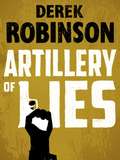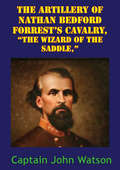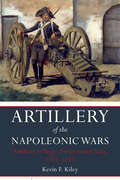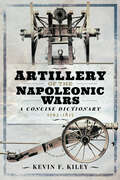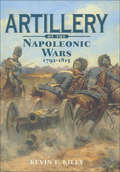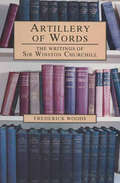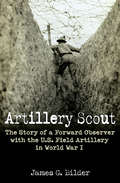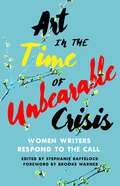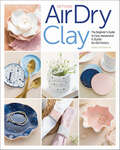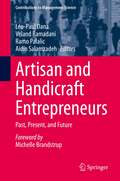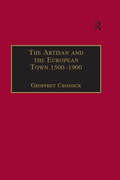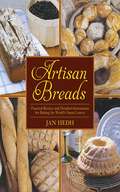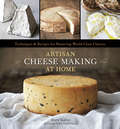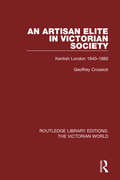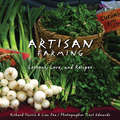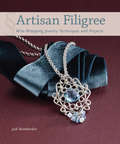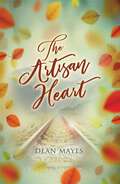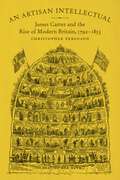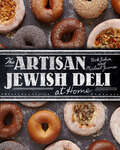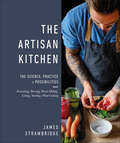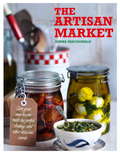- Table View
- List View
Artillery of Lies
by Derek Robinson1943. British Intelligence has finally got to grips with the Eldorado Network, Germany's most successful spy ring. It turns out to be one man in a small room in Lisbon, inventing phoney (but convincing) reports. For two years he has pulled the wool over German Intelligence's eyes, and made a killing. The British soon find that Eldorado's a real handful. They bring him to England, so they can manage his dispatches, and discover that living with a genius can be a headache. Eldorado rapidly creates a team of top sub-agents around him. None of them exists. But power - even imaginary power - is intoxicating, and he begins to treat his fake sub-agents as if real. Big trouble ahead. Artillery of Lies is the hair-raising sequel to The Eldorado Network, all the more funny for being soundly based on the true story of a real Second World War spy.
Artillery of Lies
by Derek Robinson1943. British Intelligence has finally got to grips with the Eldorado Network, Germany's most successful spy ring. It turns out to be one man in a small room in Lisbon, inventing phoney (but convincing) reports. For two years he has pulled the wool over German Intelligence's eyes, and made a killing. The British soon find that Eldorado's a real handful. They bring him to England, so they can manage his dispatches, and discover that living with a genius can be a headache. Eldorado rapidly creates a team of top sub-agents around him. None of them exists. But power - even imaginary power - is intoxicating, and he begins to treat his fake sub-agents as if real. Big trouble ahead. Artillery of Lies is the hair-raising sequel to The Eldorado Network, all the more funny for being soundly based on the true story of a real Second World War spy.
The Artillery Of Nathan Bedford Forrest’s Cavalry, “The Wizard Of The Saddle,” [Illustrated Edition]
by John Watson MortonIncludes Civil War Map and Illustrations Pack - 224 battle plans, campaign maps and detailed analyses of actions spanning the entire period of hostilities.One of the shining lights of the Confederate war effort Nathan Bedford Forrest, was an iconoclast; militarily untrained at the outbreak of the Civil War he was to wield his cavalry command with innovative doctrines, effective strategies that confounded many Union commanders. Central to his success was his hard riding mounted artillery which provided him with a heavy punch to add to his mobility.Captain John Morton rose to the post of Forrest's chief of artillery in 1864 after much service since joining the grey ranks in 1861. Many years after the end of his military service he set out to write a history of the unit he commanded, this volume is comprehensive, readable and very well-written. He charts all of the engagements and actions in which he and his men fought with detail and verve; however, the greatest insights are into the daily life of the Confederate raiders, their morale and anecdotes of his leader and his style of command.A Classic Confederate history.
Artillery of the Napoleonic Wars: Artillery In Siege, Fortress And Navy 1792-1815
by Kevin F. Kiley&“Filled with statistical information on the guns, ammunition, and carriages, used by the armies . . . places the reader on the ground with the gunners.&”—The Napoleon Series Napoleon was an artilleryman before he was an emperor. He understood the power and effectiveness of cannon and their ability to pulverize defenses, reduce fortresses and destroy attacks. In return, the guns won Napoleon battles. This impressive study chronicles the story of the guns and men during the twenty-three years of almost continuous warfare from 1792–1815: from the battlefields of continental Europe to the almost primitive terrain of North America and of the seas, lakes and rivers that connected them. Detailed technical information is accompanied by vivid descriptions which allow the reader to imagine what it must have been liked to maneuver and man the guns in a variety of situations—whether on the march or on the battlefield. Based on years of research into regulations of the period, eyewitness accounts of artillerymen and material culled from official reports, the scope and depth of material will satisfy the serious researcher, while the lively narrative will appeal to the casual reader. &“Kiley&’s research is impeccable and deserves the highest praise. Moreover, he writes in so entertaining a manner that he informs and educates without effort . . . For the enthusiastic student of the attack and defense of fortified places this is an essential book of reference.&”—Fortress Study Group
Artillery of the Napoleonic Wars: Volume I - Field Artillery, 1792-1815 (Napoleonic Library)
by Kevin F. KileyA comprehensive military history reference book exploring all aspects of the artillery used during the Napoleonic Wars.Napoleon began his military career as an artillery cadet and artillery played a fundamental part in all his great battles. Until the Napoleonic Wars artillery had been seen merely as a supporting arm to the infantry, but Napoleon changed everything. He massed his guns in huge batteries to blast holes in his opponent’s line. He even used the artillery to charge the enemy, the gunners galloping up to the enemy to open fire at pointblank range.Napoleon’s opponents did not all follow suit, choosing other tactical deployments. As a result, the Napoleonic era, more than any that preceded or followed it, was one of fascinating artillery maneuvers and critical actions that changed the course of many of the key battles. As the Prussian Field Marshal Blucher once observed, “Against Napoleon you needed guns – and lots of them!”The Napoleonic Wars was also a time of innovation, with the introduction of shrapnel shells and military rockets. This book will examine the artillery arms of all sides from ‘muzzle to butt plate’. As well as the significant artillerymen of the period, the scientists, and innovators, military and civilian—individuals such as Robins, Belidor, Gribeauval and his colleagues, Maritz, Liechtenstein and his collaborators, as well as the du Teil brothers – will all be examined, as will the important battles and sieges, significant memoirs and documents, and artillery terms that soon became part of the military lexicon.Written by the renowned historian Kevin F. Kiley, this will be the definitive book on the subject and will cover all aspects of artillery in the Napoleonic Wars.“This is a wonderfully complete induction into the details of Napoleonic Artillery. As well as defining some of the archaic terms associated with the art of gunnery (note; point blank is not what we mostly believe it to be) it provides background to the careers of the key characters in the science. The book contains many excellent technical drawings to explain, sketches and images to inform and data tables in the appendix to which to refer. Overall, it is an indispensable aid to understanding the artillery of the period.” —Michael McCarthy, battlefield guide
Artillery of the Napoleonic Wars, 1792–1815: Volume I - Field Artillery, 1792-1815 (Napoleonic Library)
by Kevin F. KileyAn extensive look at the large-caliber guns of the Napoleonic period, the battles in which they were used, and the important figures in those conflicts. In this heavily researched study, Kevin Kiley examines Napoleon&’s own artillery as well as that employed by his enemies, and he evaluates the gunners&’ contribution to warfare in the period. By looking at particular battles in detail, Kevin Kiley shows just how the effective employment of artillery could tip the scales of victory.Artillery of the Napoleonic Wars reveals much of the technical aspects of gunnery during the period—how guns were placed, their range, what calibers were preferred, how artillery operates. It examines French artillery, including that of the Imperial Guard, and compares it to that of Britain, Russia, and Austria; it also looks at many of the personalities involved and the difference between good gunnery and mediocre artillery. Illustrated with beautiful line drawings and rare contemporary plates, this unique book reveals a whole new dimension to the Napoleonic period. Based on years of research into regulations of the period, eyewitness accounts of artillerymen, and material culled from official reports, this is a definitive account.&“This must undoubtedly become the standard work for anyone interested in the artillery of the period.&” —Waterloo Journal
Artillery of Words: The Writings of Sir Winston Churchill
by Frederick WoodsAn analysis of the writings of the iconic twentieth-century statesman from the author of Young Winston&’s Wars. Only a part-time author, Sir Winston Churchill wrote fifty books and over eight hundred feature articles. He even received the Nobel Prize for Literature in 1953. Now, Frederick Woods, an internationally acknowledged expert in the field of Churchillian writings, presents a full-length appraisal of Churchill&’s literary output, while putting the writings in the context of Churchill's public life. Churchill&’s words were weapons, argues Mr. Woods, written deliberately to win a battle, whether that battle was over the future of India, the fate of the freedom-loving world, the rehabilitation of renowned ancestors, or his own fluctuating reputation. In every case Churchill strove mightily to win, and often presented his case with less objectivity than that expected of one popularly considered to be a major historian. Artillery of Words is not only an illuminating and often witty analysis of Churchill&’s writings; it is also an important and revealing contribution to Churchillian studies in general. Praise for Frederick Woods&’s A Bibliography of the Works of Sir Winston Churchill &“[Reveals] a mastery of both research and presentation.&” —Martin Gilbert, bestselling author of Churchill: A Life
Artillery Scout: The Story of a Forward Observer with the U.S. Field Artillery in World War I
by James G. Bilder“Moves quickly; it entertains and provides a decent overview of the life of an American Doughboy” on the Western Front during the Great War (San Francisco Book Review).The American Doughboys of World War I are often referred to as the “Lost Generation”; however, in this book, we are able to gain an intimate look at their experiences after being thrust into the center of Europe’s “Great War” and enduring some of the most grueling battles in US history.Len Fairfield, the author’s grandfather, was an Artillery Scout, or Forward Observer, for the US Army and was a firsthand witness to the war’s carnage as he endured its countless hardships, all of which are revealed here in vivid detail. His story takes the reader from a hard life in Chicago, through conscription, rigorous training in America and France, and finally to the battles which have become synonymous with the US effort in France—St. Mihiel and the Argonne Forest, the latter claiming 26,000 American lives, more than any other US battle.The American Expeditionary Forces endured a rare close-quarters visit to hell until it was sensed that the Germans were finally giving way, though fighting tooth-and-nail up to the very minute of the Armistice. This action-filled work brings the reader straight to the center of America’s costly battles in World War I, reminding us once again how great-power status often has to be earned with blood on battlefields.“All in all, this book is a bit of a gem. It is a well paced easy read and you will find yourself rooting for our hero.” —War in History
Artillery Warfare, 1939–1945
by Simon Forty Jonathan Forty“From mountain warfare with guns on mules to V2 rockets and everything between makes it well worth a place on anyone’s reference shelf.” —Clash of SteelIt is said that artillery won the Second World War for the Allies—that Soviet guns wore down German forces on the Eastern Front, negating their superior tactics and fighting ability, and that the accuracy and intensity of the British and American artillery was a major reason for the success of Allied forces in North Africa from El Alamein, in Italy and Normandy, and played a vital role in the battles of 1944 and 1945. Yet the range of weapons used is often overlooked or taken for granted—which is why this highly illustrated history by Simon and Jonathan Forty is of such value. They stress the importance of artillery on every front and analyze how artillery equipment, training and tactical techniques developed during the conflict.The selection of wartime photographs—many from east European sources—and the extensive quotations from contemporary documents give a graphic impression of how the guns were used on all sides. The photographs emphasize the wide range of pieces employed as field, antiaircraft and antitank artillery without forgetting self-propelled guns, coastal and other heavyweights and the development of rockets. The authors offer a fascinating insight into the weapons that served in the artillery over seventy years ago.“Superbly illustrated, this is testament to the courage and skills of extraordinary men in the execution of their duty. An amazing book.” —Books Monthly
Art in the Time of Unbearable Crisis: Women Writers Respond to the Call
by Stephanie RaffelockArt keeps good alive in the worst of times. In the face of ugliness, pain, and death, it’s art that has the power to open us all to a healing imagining of new possibility; it’s art that whispers to the collective that even in the ashes of loss, life always grows again. That’s why right now, in this tumultuous time of war and pandemic, we need poets more than we need politicians. In response to the multitude of global crises we’re currently experiencing, editor Stefanie Raffelock put out a much-needed call to her writing community for art to uplift and inform the world, and the authors of She Writes Press answered. Art in the Time of Unbearable Crisis—a sometimes comforting, sometimes devastating, but universally relatable collection of prose, poetry, and art about living through difficult times like these—is the result. Addressing topics including grief and loss, COVID-19 and war in Ukraine, the gravity of need and being needed, the broad range of human response to crisis in all its forms, and more, these pieces explore how we can find beauty, hope, and deeper interpretation of world events through art—even when the world seems like it’s been turned inside out and upside-down. Proceeds: Our Commitment The collection of essays, poetry, and art in this book are meant to feed and nourish our hearts and minds. It’s what women do—we feed people. To that end, the proceeds from this work will be donated to the nonprofit World Central Kitchen, an organization conceived by chef José Andrés as a way to feed people affected by natural disasters and war.World Central Kitchen financially supports food banks and restaurants that provide free food throughout the world.
Artisan Air-Dry Clay: The Beginner's Guide to Easy, Inexpensive & Stylish No-Kiln Pottery
by Radka HostasovaNo Kiln? No Problem! Learn to make beautifully textured home décor accents with inexpensive air-dry clay! The process is easy, and the results are surprisingly stylish when you follow the tips, advice, and instruction from author and clay artist-designer Radka Hostasova. Aimed at absolute beginners—this book starts with an overview of the tools and materials needed to produce the best results. A comprehensive "Getting Started" chapter teaches essential home pottery techniques such as rolling slab, coiling, sculpting, and pinching. Also included are creative ideas for adding color with acrylic paint, watercolor, and metallics. At the book's heart are a range of beautiful projects, including trinket bowls, napkin rings, wall hangings, coasters, and others. Each lesson comes with a detailed reference photograph and easy-to-follow step-by-step instructions. Roll, coil, sculpt and carve air-dry clay to create beautiful projects Make modern and stylish projects such as coasters, trinket dishes, home décor accents, kid's projects, and more Use easy home pottery as a mode of relaxation and stress relief
Artisan and Handicraft Entrepreneurs: Past, Present, and Future (Contributions to Management Science)
by Léo-Paul Dana Veland Ramadani Ramo Palalic Aidin SalamzadehIn handicrafts and artisanal products, industry has witnessed both a technological shift and a renewed interest among customers, especially after the challenges and limitations of mass production became evident under the COVID-19 pandemic. This book portrays the worldwide development of this trend, the nature of entrepreneurship in these industries, and the unique challenges and opportunities that entrepreneurs face. The book shows how these businesses are gaining a resurgence due to customers preferring ethical, regional, and climate-friendly options to fulfill their needs. The chapters focus on artisan entrepreneurs' contribution to society by not only creating businesses, but also in terms of tourism development. The book reiterates that artisan entrepreneurs enable crucial cultural connections with tradition due to their affinity to a region, city, village, or community. Small business and entrepreneurship researchers as well as policymakers in the cultural sector would benefit from this book.
The Artisan and the European Town, 1500–1900 (Historical Urban Studies Series)
by Geoffrey CrossickArtisans played a central role in the European town as it developed from the Middles Ages onwards. Their workshops were at the heart of productive activity, their guilds were often central to the political and legal order of towns, and their culture helped shape civic ritual and the urban order. These essays, which have all been specially written for this collection, explore the relationships between artisans and their towns across Europe between the beginning of the early-modern period and the end of the 19th century. They pay special attention to the processes of economic, juridicial and political change that have made the 18th and early 19th centuries a period of such significance. Written by leading historians of European artisans, the essays question the myths about artisans that have long pervaded research in the field. The leading myth was that shared by the artisans themselves - the myth of decline and the belief in each generation that artisans in the past had inhabited a better age. These essays open up for debate the nature of artisanship, the way economic change affected craft production, the political role of artisans, the cultural identification of the artisans with work and masculinity, and the way changing urban society and changing urban structure posed threats to which the artisans had to respond.
Artisan Breads: Practical Recipes and Detailed Instructions for Baking the World's Finest Loaves
by Jan HedhIn this beautifully photographed book, master baker Jan Hedh teaches us the basics for baking delicious artisan breads right in our own ovens. Hedh offers a cookbook full of recipes for all occasionsOCofrom daily loaves for sandwiches to delectable sweet breads for special occasions. This cookbook includes master tips on how to bake bread for maximum taste and aroma, the proper way to knead dough, the type of flour to use, and the correct baking time and oven temperature. With his wide breadth of recipes from all over the worldOCoincluding Italian, French, Swiss, German, Arabic, and of course Swedish breadsOCothis book is a must-have for all those who love to bake. "
Artisan Cheese Making at Home: Techniques & Recipes for Mastering World-Class Cheeses [A Cookbook]
by Ed Anderson Mary KarlinJust a century ago, cheese was still a relatively regional and European phenomenon, and cheese making techniques were limited by climate, geography, and equipment. But modern technology along with the recent artisanal renaissance has opened up the diverse, time-honored, and dynamic world of cheese to enthusiasts willing to take its humble fundamentals--milk, starters, coagulants, and salt--and transform them into complex edibles. Artisan Cheese Making at Home is the most ambitious and comprehensive guide to home cheese making, filled with easy-to-follow instructions for making mouthwatering cheese and dairy items. Renowned cooking instructor Mary Karlin has spent years working alongside the country's most passionate artisan cheese producers--cooking, creating, and learning the nuances of their trade. She presents her findings in this lavishly illustrated guide, which features more than eighty recipes for a diverse range of cheeses: from quick and satisfying Mascarpone and Queso Blanco to cultured products like Crème Fraîche and Yogurt to flavorful selections like Saffron-Infused Manchego, Irish-Style Cheddar, and Bloomy Blue Log Chèvre. Artisan Cheese Making at Home begins with a primer covering milks, starters, cultures, natural coagulants, and bacteria--everything the beginner needs to get started. The heart of the book is a master class in home cheese making: building basic skills with fresh cheeses like ricotta and working up to developing and aging complex mold-ripened cheeses. Also covered are techniques and equipment, including drying, pressing, and brining, as well as molds and ripening boxes. Last but not least, there is a full chapter on cooking with cheese that includes more than twenty globally-influenced recipes featuring the finished cheeses, such as Goat Cheese and Chive Fallen Soufflés with Herb-Citrus Vinaigrette and Blue Cheese, Bacon, and Pear Galette. Offering an approachable exploration of the alchemy of this extraordinary food, Artisan Cheese Making at Home proves that hand-crafting cheese is not only achievable, but also a fascinating and rewarding process.From the Hardcover edition.
An Artisan Elite in Victorian Society: Kentish London 1840-1880 (Routledge Library Editions: The Victorian World #9)
by Geoffrey CrossickFirst published in 1978. Mid-Victorian Britain was relatively stable in comparison with the turbulent period that preceded it, and that stability is in part explained by the emergence of an artisan elite with a specific relationship to the society around it. This book examines that elite: its clubs and societies, co-operatives and building societies; its values and ideology, challenging the notion that these artisans directly absorbed middle-class values; its politics, tracing the evolution from Chartism through the Reform League and on to a radical liberalism which existed in constant tension with the local liberal middle class. A careful reconstruction of the social, political and industrial life of these artisans is set within the context of the local communities, and their understanding of the mid-Victorian society in which they lived is seen as the explanation for their values and activities. This title makes a major contribution towards our understanding of the nineteenth-century working class.
Artisan Farming: Lessons, Lore, and Recipes
by Richard Harris Lisa FoxExplore the unique farming culture of New Mexico through stories, recipes, and photographs in this book of rustic artisanal living. Life is hard for the artisanal farmers of New Mexico—but they wouldn't have it any other way. They take pride in their land, their soil, their crops, and their families. Competition for business is friendly and cordial. Neighbors help neighbors, and community is key. They eagerly await the farmers markets not only to sell their wares, but to renew their friendships and swap stories of their mishaps, trials, and adventures. Laden with rich photos, ripe with human interest stories, and bounteous with tantalizing recipes, Artisan Farming explores this state's one-of-a-kind agricultural heritage and the revival of traditional, organic, and "artisan" farming. Readers will discover the small farms, farmers' markets, community-supported agriculture organizations, heritage seed exchanges, and other entries that have made the independent farming revival possible.
Artisan Filigree: Wire-Wrapping Jewelry Techniques and Projects
by Jodi BombardierEnjoy a collection of 20+ beautiful wire projects! Inspired by the ironwork so prevalent in her native Tucson, Jodi Bombardier fashions her signature heavygauge wire frames into sinuous shapes, cold-joining them with fine wire to form open, lacy filigree patterns. Learn Jodi's techniques, including the correct ways to use tools, hold wire, and create shaped wire frames consistently and precisely. Create airy pieces that are still strong and stable enough to withstand daily wear. Build confidence in your wirework skills as projects increase in complexity. In addition to providing project instructions, Jodi demonstrates how her scrolled designs can be manipulated, joined, or rearranged to create endless variations limited only by the imagination.
The Artisan Heart
by Dean MayesFans of The Artisan Heart are saying "such a good book, I didn't want it to end", "small town charm at its finest" and "a feel good, heartwarming story".Hayden Luschcombe is a brilliant paediatrician living in Adelaide with his wife Bernadette, an ambitious event planner. His life consists of soul-wrenching days at the hospital and tedious evenings attending the lavish parties organized by Bernadette.When an act of betrayal coincides with a traumatic confrontation, Hayden flees Adelaide, his life in ruins. His destination is Walhalla, nestled in Australia&’s southern mountains, where he finds his childhood home falling apart. With nothing to return to, he stays, and begins to pick up the pieces of his life by fixing up the house his parents left behind.A chance encounter with a precocious and deaf young girl introduces Hayden to Isabelle Sampi, a struggling artisan baker. While single-handedly raising her daughter, and trying to resurrect a bakery, Isabelle has no time for matters of the heart. Yet the presence of the handsome doctor challenges her resolve. Likewise, Hayden, protective of his own fractured heart, finds something in Isabelle that awakens dormant feelings of his own.As their attraction grows, and the past threatens their chance at happiness, both Hayden and Isabelle will have to confront long-buried truths if they are ever to embrace a future.Be sure to also read Dean Mayes' other novels:The Hambledown DreamGifts of the PeramangkThe Recipient
The Artisan Herbalist: Making Teas, Tinctures, and Oils at Home (Homegrown City Life)
by Bevin CohenStart your journey as an artisan herbalist and take back control of your health and well-being the natural way with this accessible guide.From urban apartments to wild countryside, The Artisan Herbalist is an easy-to-use guide that teaches you how to identify, grow, harvest, forage, and craft herbal allies into an assortment of useful health and wellness products. Through storytelling and step-by-step instruction, The Artisan Herbalist covers:The uses and benefits of thirty-eight easy-to-find yet powerful herbsHarvesting from the wild, foraging in the city, and using store-bought herbsGrowing herbs in small areas, balconies, and potsPrinciples, tips, techniques, and formulas to create teas and tincturesInfusing oils for the creation of salves, lotions, and balmsBeneficial herb-based recipesMarketing and selling your products through a home-based businessWhether you live in the city, suburbs, or countryside, take back control of your health and begin your journey toward independent self-care as a budding artisan herbalist.Praise for The Artisan HerbalistWinner, 2022 International Book Award, Health: Alternative Medicine“A thoroughly delightful, practical, and well-organized introduction to the uses of plants as medicine and food.” —Rosemary Gladstar herbalist and author, Rosemary Gladstar’s Medicinal Herbs“A masterpiece! Not only is this book beautiful, but it is highly useful. . . . This is the book every beginner herbalist should have on hand to start on their herbal path.” —Kristine Brown RH (AHG), author, Herbal Roots zine, Herbalism at Home, The Homesteader’s Guide to Growing Herbs, and Nature Anatomy Activities for Kids
An Artisan Intellectual: James Carter and the Rise of Modern Britain, 1792-1853
by Christopher FergusonIn An Artisan Intellectual, Christopher Ferguson examines the life and ideas of English tailor and writer James Carter, one of countless and largely anonymous citizens whose lives dramatically transformed during Britain’s long march to modernity. Carter began his working life at age thirteen as an apprentice and continued to work as a tailor throughout the first half of the nineteenth century, first in Colchester and then in London. As the Industrial Revolution brought innovations to every aspect of British life, Carter took advantage of opportunities to push against the boundaries of his working-class background. He supplemented his income through his writing, publishing often unsigned books, articles, and poems on subjects as diverse as religion, death, nature, aesthetics, and theories of civilization. Carter’s words give us a fascinating window into the revolutionary forces that upended the world of ordinary citizens in this era and demonstrate how the changes in daily life impacted personal experiences and intellectual pursuits as well as labor practices and living and working environments. Ferguson deftly explores a forgotten tailor’s varied responses to the many transformations that produced the world’s first modern society.
The Artisan Jewish Deli at Home
by Nick Zukin Michael ZusmanEasily enjoy Jewish deli classics and modern updates at home with this collection of recipes that is sure to make you kvell.If you don’t happen to live near one of the new wave of artisan-style Jewish delis that have sprung up around North America over the last few years, not to worry. With this book, the world of Jewish deli, in all its unsubtle splendor, can be yours in the comfort (and privacy) of your own kitchen. And it’s not that hard. Really. On top of all the Jewish deli classics, The Artisan Jewish Deli at Home offers updates and new angles on the old ways that are bound to thrill the palates of a modern generation of eaters focused on quality ingredients and a lighter-handed approach to a traditionally heavy cuisine.The chapters are organized into Starters and Sides; Soups and Salads; Eggs, Fish, and Dairy; Beef; Bagels, Bialys, and Breads; and Pastries, Desserts, and Drinks. The range of favorite recipes include: Crispy Potato Latkes with Chunky Ginger Applesauce; Summer Chicken Salad with Tomatoes, Cucumber and Cracklings; Wise Sons’ Chocolate Babka French Toast; Home Oven Pastrami; and Celery Soda.Added cultural context comes from quick-hitting interviews with Joan Nathan and other Jewish food luminaries; histories of a few deli stalwarts such as bagels and pastrami; and first-hand reports from within the walls of the authors’ favorite temples of modern Jewish gastronomy located across the country including: Mile End Delicatessen in New York City; Wise Sons Delicatessen in San Francisco; Kenny & Zuke’s Delicatessen in Portland, Oregon; Stopsky’s Delicatessen in Mercer Island, Washington; and Caplansky’s Delicatessen in Toronto.Praise for The Artisan Jewish Deli at Home“If my grandmother, the greatest Jewish deli–style cook I’ve ever known, were alive she’d be kvelling over this book.” —Ed Levine, founder of Seriouseats.com“Michael and Nick’s handsome book brings some of your favorite deli recipes and memories into your home kitchen. Their pickles, knishes, and pastrami are just like you remember, only better!” —Joan Nathan, author of Jewish Cooking in America“The Artisan Jewish Deli at Home will turn any house into a delicatessen worth its weight in knishes.” —David Sax, author of Save the Deli
The Artisan Jewish Deli at Home
by Nick Zukin Michael ZusmanEasily enjoy Jewish deli classics and modern updates at home with this collection of recipes that is sure to make you kvell.If you don’t happen to live near one of the new wave of artisan-style Jewish delis that have sprung up around North America over the last few years, not to worry. With this book, the world of Jewish deli, in all its unsubtle splendor, can be yours in the comfort (and privacy) of your own kitchen. And it’s not that hard. Really. On top of all the Jewish deli classics, The Artisan Jewish Deli at Home offers updates and new angles on the old ways that are bound to thrill the palates of a modern generation of eaters focused on quality ingredients and a lighter-handed approach to a traditionally heavy cuisine.The chapters are organized into Starters and Sides; Soups and Salads; Eggs, Fish, and Dairy; Beef; Bagels, Bialys, and Breads; and Pastries, Desserts, and Drinks. The range of favorite recipes include: Crispy Potato Latkes with Chunky Ginger Applesauce; Summer Chicken Salad with Tomatoes, Cucumber and Cracklings; Wise Sons’ Chocolate Babka French Toast; Home Oven Pastrami; and Celery Soda.Added cultural context comes from quick-hitting interviews with Joan Nathan and other Jewish food luminaries; histories of a few deli stalwarts such as bagels and pastrami; and first-hand reports from within the walls of the authors’ favorite temples of modern Jewish gastronomy located across the country including: Mile End Delicatessen in New York City; Wise Sons Delicatessen in San Francisco; Kenny & Zuke’s Delicatessen in Portland, Oregon; Stopsky’s Delicatessen in Mercer Island, Washington; and Caplansky’s Delicatessen in Toronto.Praise for The Artisan Jewish Deli at Home“If my grandmother, the greatest Jewish deli–style cook I’ve ever known, were alive she’d be kvelling over this book.” —Ed Levine, founder of Seriouseats.com“Michael and Nick’s handsome book brings some of your favorite deli recipes and memories into your home kitchen. Their pickles, knishes, and pastrami are just like you remember, only better!” —Joan Nathan, author of Jewish Cooking in America“The Artisan Jewish Deli at Home will turn any house into a delicatessen worth its weight in knishes.” —David Sax, author of Save the Deli
The Artisan Kitchen: The science, practice and possibilities
by James StrawbridgeReconnect with a more mindful way of cooking and spark your creativity.Giving a modern twist to age-old techniques, this book shows how to master 25 different cooking and preserving processes, from fermenting to cheese making, hot smoking to sourdough baking.Discover how to culture the perfect batch of sweet-sour kombucha; make a fresh-tasting chutney; dry cure bresaola; create your own unique sourdough starter; and slow roast over an open wood fire. Be inspired to experiment with more than 150 recipe ideas.Embark on your next culinary adventure and revolutionize your enjoyment of food. Escape to The Artisan Kitchen.
The Artisan Market
by Emma MacdonaldEveryone can enjoy the fruits of their labors with Artisan Preserving, the seminal book on canning, which provides a one-stop resource. Whether you have foraged hedgerows, picked produce from your own vegetable garden or allotment, or searched out the best seasonal buys in the supermarket or market, this book contains more than 100 delicious recipes for preserving fruit and vegetables, meat or fish. Emma Macdonald gives clear and comprehensive instructions for curing, drying, pickling, bottling/canning, crystalizing and jellying; as well as recipes for all kinds of jams, jellies, pickles, chutneys, relishes, cordials, fruit liqueurs, sauces, confits and terrines, fruit curds, cheeses and butters, and dried fruits and vegetables. Every classic is covered, including: gravlax, confit chicken, candied peel, quince cheese, elderflower cordial, mint jelly, onion marmalade, mango chutney, sloe gin, raspberry jam and piccalilli. There are many others, some of them centuries old, many of them with a modern twist, such as Banana and Date Chutney and Grapefruit and Elderflower Marmalade. Emma also includes expert tips on troubleshooting and information on all the equipment you will need. Pick up your cheesecloths and straining funnel and get preserving!
